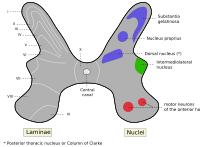
Photo from wikipedia
OBJECTIVE Naftopidil is used clinically for the treatment of voiding disorders in benign prostatic hyperplasia. Previous in vivo experiments in which naftopidil was applied intrathecally abolished rhythmic bladder contraction, suggesting… Click to show full abstract
OBJECTIVE Naftopidil is used clinically for the treatment of voiding disorders in benign prostatic hyperplasia. Previous in vivo experiments in which naftopidil was applied intrathecally abolished rhythmic bladder contraction, suggesting that naftopidil might inhibit a voiding reflex through interaction with spinal dorsal horn neurons. Here we aimed to clarify the mechanism of action of naftopidil on dorsal horn neurons. METHODS Whole-cell patch-clamp recordings were performed using substantia gelatinosa neurons of adult rat spinal cord slices. Miniature or evoked inhibitor and excitatory postsynaptic currents (IPSCs and EPSCs, respectively) were analyzed. RESULTS Bath-applied naftopidil increased the frequency but not the amplitude of miniature IPSCs (mIPSCs) in 38% of neurons tested; in contrast, the effect of naftopidil on miniature EPSCs (mEPSCs) were mild and observed in only 2 out of 19 neurons. Naftopidil enhanced the amplitude of both GABAergic and glycinergic evoked-IPSCs (eIPSCs) that were elicited by focal stimuli in the presence of either the non-NMDA receptor antagonist 6-cyano-7-nitroquinoxaline-2,3-dione (CNQX), or the NMDA receptor antagonist DL-2-amino-5-phosphonovaleric acid (APV). CONCLUSIONS Although naftopidil was developed as an alpha-1 adrenoceptor antagonist, our previous spinal cord slice experiments showed that the activation of an alpha-1 adrenoceptor in substantia gelatinosa increases the frequency of mIPSCs. This result suggested that, under our conditions, naftopidil may interact with a receptor(s) other than an alpha-1 adrenoceptor in the spinal dorsal horn. The present results suggested that naftopidil enhances the release of GABA and glycine by activating inhibitory interneuron terminals in the spinal dorsal horn via a receptor other than an alpha-1 adrenoceptor, thereby modulating sensory transmission in the substantia gelatinosa.
Journal Title: Journal of the Neurological Sciences
Year Published: 2017
Link to full text (if available)
Share on Social Media: Sign Up to like & get
recommendations!